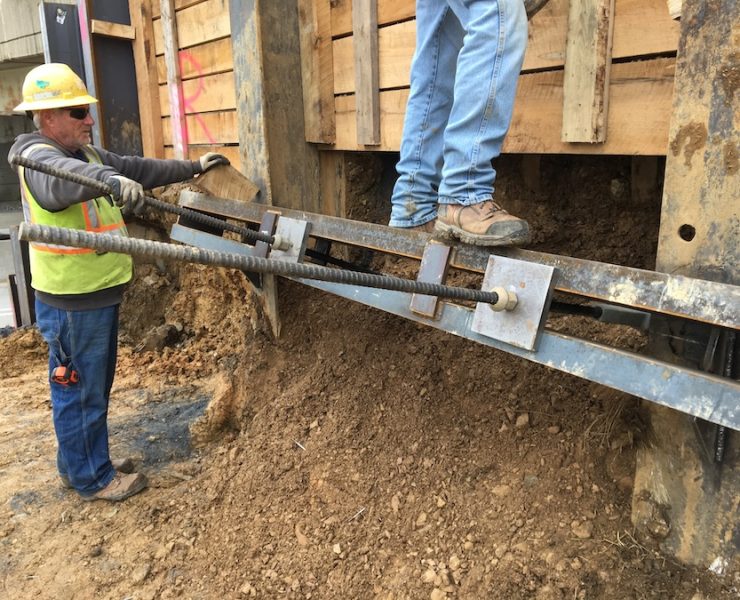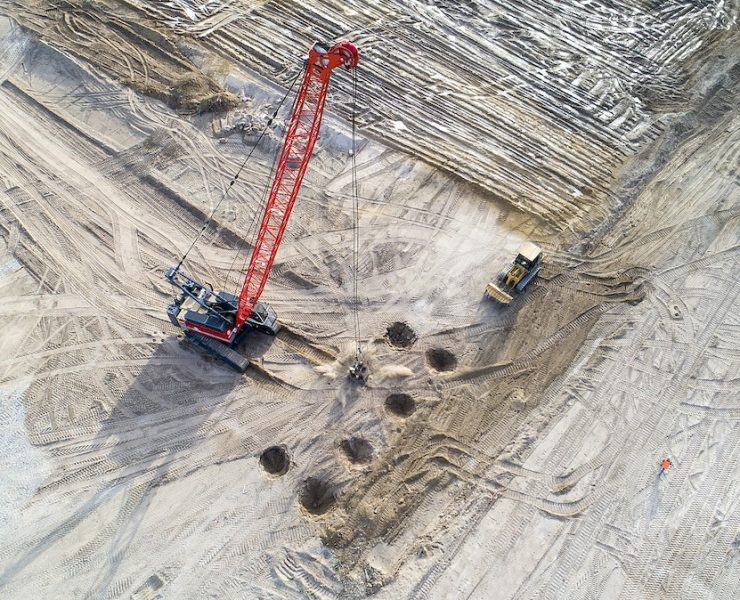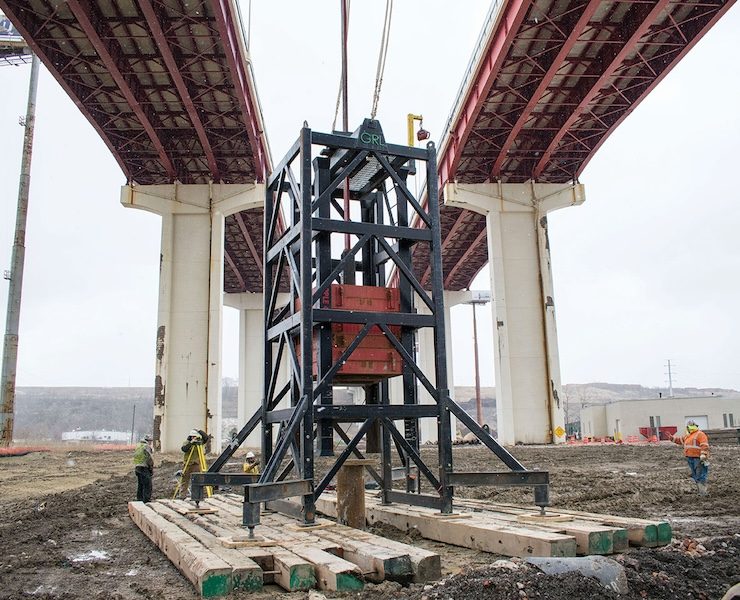Pile Cutting Procedures, Challenges, Quality Control, and Equipment
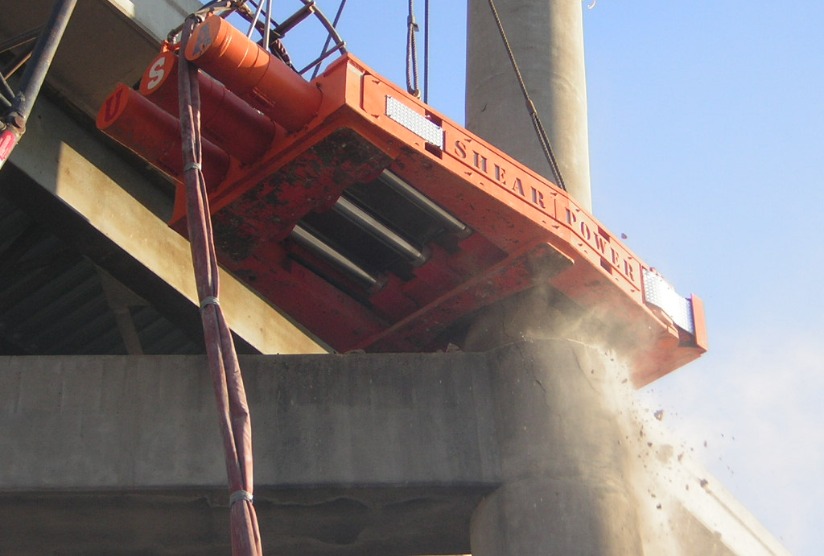

View the complete article here.
Pile cutting refers to the process of trimming or leveling the upper part of foundation piles, either to a predetermined elevation or to remove damaged portions. This procedure is crucial in ensuring that the pile head is prepared to receive structural connections or to fit into other parts of the foundation system, such as pile caps or beams.
We have already covered the different pile types in numerous articles. For this reason, we will quickly summarize this information to provide context for this article:
- Driven Piles: These are piles that are installed by hammering or driving them into the ground. They can be made from a variety of materials, including:
- Timber: These are wooden piles, generally used for lighter structures or temporary works.
- Precast concrete: As the name suggests, these piles are made of concrete and are cast before being driven into the ground. They are durable and can bear substantial loads.
- Steel: These piles are often in the form of H-sections or tubular sections. They have high load-bearing capacities and are resistant to bending.
- Bored Piles: Unlike driven piles, bored piles are formed by excavating or boring a hole in the ground and then filling it with concrete. Some common types include:
- Auger-bored piles: These are formed by using a rotating auger to drill into the ground. Once the desired depth is reached, the hole is filled with concrete.
- Drilled shafts: Also known as caissons, these are large diameter bored piles. The excavation process for these piles can be more intricate, often involving temporary casing or drilling mud to stabilize the hole.
Both driven and bored piles have their specific applications—chosen based on ground conditions, load requirements, and other project-specific factors. The type of pile, whether driven or bored, also influences the method and intricacies of pile cutting—as different materials and installation processes can result in varied challenges and requirements during the cutting phase.
Reasons for Pile Cutting
Here are the primary reasons why pile cutting is an essential procedure in foundation engineering…
Leveling and Finishing
Piles, after being driven or cast in-situ (constructed directly at its final location), may not always be at the precise required elevation due to variations in ground conditions or slight inaccuracies during installation. Leveling ensures that the tops of all piles are uniform and at the desired height, creating a stable platform for the subsequent phases of construction. Finishing, on the other hand, refers to the process of giving the cut pile a smooth and even surface. This ensures that there is a proper bond and fit when the pile interacts with other structural elements or when any protective or binding materials are applied.
Structural Modifications
In certain situations, it may be necessary to modify the structure of the pile post-installation. This could be due to changes in the design, unforeseen ground conditions, or the detection of flaws in the pile. Cutting can be used to remove sections of the pile that are deemed structurally unsound or to make adjustments to its length or profile to cater to revised design requirements.
Overdriving Corrections
Overdriving refers to a scenario where a pile has been driven deeper than its intended depth. This can happen due to softer ground conditions than anticipated or excessive force applied during the driving process. When a pile is overdriven, it might go beyond the design depth—potentially affecting the structural performance and load-bearing capacity of the pile. Pile cutting can be employed to rectify this, ensuring the pile is brought back to the desired level and its integrity is maintained.
Integration with Pile Caps or Beams
Piles serve as a foundational element that often connects with other structural components, like pile caps or beams. These components distribute loads from the superstructure across multiple piles. For a seamless and structurally sound connection, it’s crucial that the tops of the piles are cut to a precise level and finished adequately. This ensures that the pile caps or beams sit flush on the pile, allowing for optimal load transfer and structural continuity.
Pile cutting is more than just a cosmetic process—it is a critical step to ensure the structural soundness and effectiveness of foundation systems in various construction scenarios.
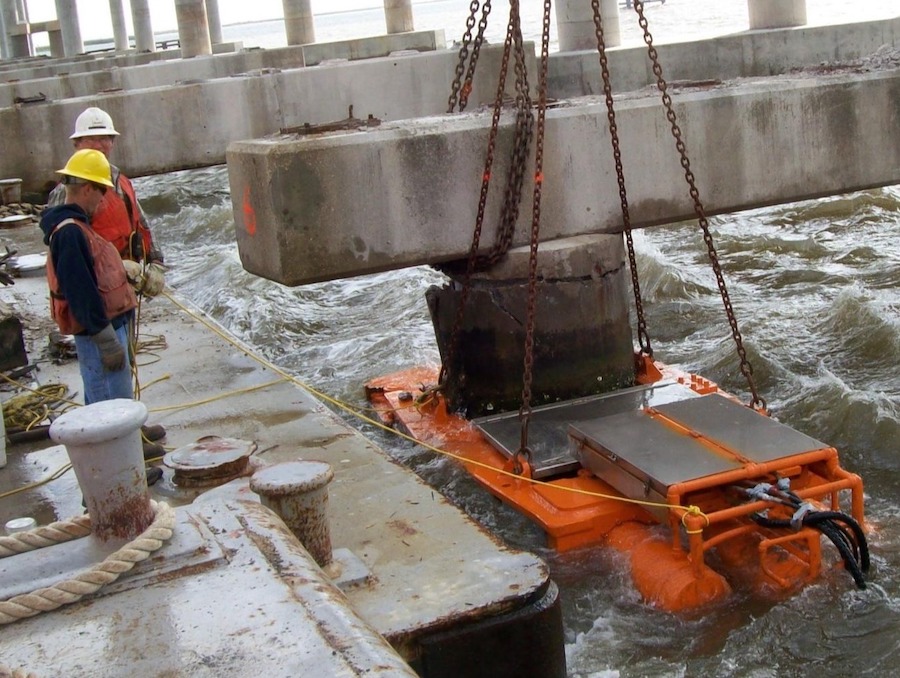
Applications of Pile Cutting
Commonly found in building foundations, bridge foundations, marine structures, and more— pile cutting is not just limited to a singular application.
Building Foundations
In modern skyscrapers, as well as mid-rise buildings—guaranteeing a strong and stable foundation is paramount. Pile cutting is employed to achieve uniformity and precision in the foundation piles, ensuring the building remains stable and distributes loads uniformly to the underlying soil or bedrock.
Bridge Foundations
Bridges, especially those spanning water bodies or vast terrains, rely on deep foundations to bear the immense loads and counter environmental factors. Pile cutting ensures that these foundation piles are of the exact required length and can seamlessly integrate with the bridge’s superstructure, providing a long-lasting and robust base.
Marine Structures
Piers, jetties, sea walls, and offshore platforms are subjected to the relentless force of waves, tides, and corrosive saltwater. Pile cutting in marine structures ensures that the piles, often exposed to these challenging conditions, maintain their integrity and can be effectively connected to other structural elements—providing durability in these aggressive environments.
Reinforced Concrete Structures
Buildings and structures made of reinforced concrete frequently use piles to ensure stability, especially in areas with weak soils. In these scenarios, pile cutting guarantees that the tops of these piles are prepared to bond with the reinforced concrete slabs, beams, or columns—ensuring a cohesive and strong structural system.
Repair and Retrofit Projects
Older buildings and other structures might require upgrades or repairs to meet current safety standards or to enhance their performance. Pile cutting is integral to such retrofit projects, helping remove damaged sections of piles or adjust their heights to accommodate new design elements or to correct past construction errors.
The practice of pile cutting is an indispensable step in the construction process to ensure the durability, stability, and safety of structures worldwide.
Equipment and Tools for Pile Cutting
The practice of pile cutting requires various tools and machinery, each tailored for specific conditions and requirements.
Hand Tools (e.g., Chisels, Saws)
- Advantages:
- Cost-effective for small-scale projects.
- Offers precision for delicate or intricate cuts.
- No need for power sources or specialized training.
- Disadvantages:
- Labor-intensive and time-consuming.
- May not be suitable for harder materials or larger piles.
- Increased risk of inconsistencies.
Mechanical Pile Cutters
- Advantages:
- Faster than hand tools for medium to large-scale projects.
- Provides a consistent cut across multiple piles.
- Reduces manual labor effort.
- Disadvantages:
- May require specialized training to operate.
- Can be noisy and generate vibration, impacting surrounding structures.
- Not as precise as some other methods.
Shearing Pile Cutters
- Advantages:
- Provides a swift and efficient cut, minimizing vibration and disturbances.
- Maintains the structural integrity of the pile during the cutting process.
- Ideal for projects requiring quick turnarounds without compromising quality.
- Disadvantages:
- May not be suitable for all pile materials or diameters.
- Equipment can be more expensive compared to basic mechanical cutters.
- Requires trained operators for optimal results.
Hydraulic Pile Cutters
- Advantages:
- Offers a clean and precise cut with minimal vibration.
- Can handle dense materials like reinforced concrete.
- Suitable for large-scale projects and challenging conditions.
- Disadvantages:
- Equipment can be expensive to purchase or rent.
- Requires specialized training and safety precautions.
- Potential for hydraulic fluid leaks, posing environmental concerns.
Diamond Wire Saws
- Advantages:
- Provides very precise and smooth cuts.
- Can cut through extremely hard materials, including heavily reinforced concrete.
- Generates minimal noise and vibration.
- Disadvantages:
- Equipment and diamond wire can be costly.
- Can be slower than other methods due to the precision involved.
- Requires a consistent water source to cool and lubricate the wire.
The choice of pile cutting equipment mainly depends on the specific requirements of the project, the materials in question, and the desired outcomes. It’s important to weigh the advantages and disadvantages of each option to determine the most efficient, cost-effective, and safe method for any given scenario.
Safety Considerations for Pile Cutting
Ensuring safety during pile cutting is paramount, not just to protect the personnel involved but also to safeguard the integrity of structures and prevent accidents.
Personal Protective Equipment (PPE)
It’s essential for all workers involved in pile cutting to wear appropriate PPE, including:
- Safety helmets: To protect against falling debris or accidental hits.
- Safety glasses or goggles: To shield eyes from flying particles and dust.
- Ear protection: Given the noise levels of many cutting tools, earplugs or earmuffs should be considered.
- Gloves: To guard hands against abrasions, cuts, and vibration.
- Safety boots: Preferably steel-toed, to protect feet from heavy objects or sharp debris.
- High-visibility vests: Ensuring workers are easily noticeable, especially in low-light conditions or busy sites.
Safe Operation of Equipment
Operators must:
- Be trained in the specific equipment they are using.
- Understand the manufacturer’s guidelines and safety precautions.
- Regularly inspect equipment for wear, damage, or malfunctions.
- Ensure that all safety guards and features are in place and functional.
Risk Assessments and Hazard Identification
Before embarking on any pile cutting venture:
- Conduct a thorough risk assessment of the site to identify potential hazards.
- Address factors like ground stability, proximity to other structures, and environmental considerations.
- Establish clear communication protocols and emergency response measures.
- Maintain a safety perimeter around the cutting area, with clear signage to keep unauthorized personnel at a distance.
Measures to Prevent Structural Collapse or Damage
Ensuring the structural stability of piles and surrounding structures during cutting is crucial.
- Continuously monitor the pile’s stability during the cutting process.
- Avoid cutting too many piles simultaneously, as this can compromise the stability of the structure.
- Employ shoring or bracing techniques when necessary.
- Engage structural engineers or experts when planning cuts near load-bearing elements or when there’s a risk of undermining structural integrity.
Safety in pile cutting operations is a comprehensive process that requires meticulous planning, adherence to protocols, and ongoing vigilance. These measures ensure the well-being of all involved and the success of the construction project.
Pile Cutting Procedures
Efficient and effective pile cutting isn’t just about having the right tools… It’s also about following a systematic approach.
1. Planning and Preparations
Before any actual cutting begins:
- Evaluate the site conditions, including soil stability and the presence of nearby structures.
- Review structural designs and blueprints to understand load-bearing aspects and design intricacies.
- Coordinate with stakeholders, including structural engineers, to ensure that the cutting aligns with the project’s broader objectives.
- Secure all necessary permits and clearances, particularly if the site is in a sensitive area.
2. Marking the Cutting Level
Precision is crucial to pile cutting:
- Use accurate measuring tools, such as laser levels or traditional spirit levels, to determine the exact cutting height.
- Mark the intended cut line clearly, ensuring it’s visible even in low-light conditions or from a distance.
- Reconfirm measurements to eliminate the possibility of errors.
3. Selecting the Appropriate Cutting Method
Depending on the pile material, size, and project requirements, choose the most suitable cutting technique:
- Hand tools might suffice for smaller or softer piles.
- Mechanical or hydraulic cutters are beneficial for medium to large-scale projects or denser materials.
- Diamond wire saws or specialized methods could be necessary for heavily reinforced concrete or precision cuts.
4. The Actual Cutting Process
Once everything’s in place:
- Ensure all safety protocols are adhered to, with personnel wearing the required PPE.
- Operate the cutting equipment as per the manufacturer’s guidelines, maintaining a steady pace to ensure a clean cut.
- Continuously monitor the pile’s stability and make adjustments if any unforeseen issues arise.
- Upon completion, inspect the cut surface for irregularities or imperfections that might need additional finishing.
5. Disposal of Cut-off Materials
After cutting, you’re often left with chunks of unwanted material:
- Sort the debris based on material type—concrete, steel, wood—for efficient recycling or disposal.
- Use appropriate methods to transport the debris, ensuring safety and avoiding spillage.
- Dispose of or recycle the material in accordance with local regulations and environmental guidelines, minimizing the environmental footprint of the operation.
To ensure efficient pile cutting—attention to detail, expertise, and an unwavering commitment to safety is crucial.
Challenges and Common Issues in Pile Cutting
Pile cutting, while methodical, often presents challenges that demand adept handling to ensure the integrity of the foundation and the safety of the surroundings.
Mastering the Vertical Cut
One of the primary concerns in the pile cutting operation is ensuring perfectly vertical cuts, which are vital for structural uniformity and seamless integration with superstructures. Precision tools like laser levels or plumb bobs are invaluable in verifying vertical alignment, and it’s essential that equipment is routinely calibrated and checked for any deviations. When manual methods are utilized, workers must be trained in techniques that uphold a straight cut and their progress checked at regular intervals.
Unearthing Obstructions and Embedded Elements
Another challenge in urban or complex settings is encountering obstructions or embedded elements such as steel rebar within the piles. Proactive measures, like scanning the piles using ground-penetrating radar (GPR) or ultrasonic testing, can identify these obstructions early in the process. If these obstructions are discovered, it is important to adjust the cutting technique or employ equipment that can manage elements like steel—ensuring that the structural integrity of embedded networks like rebar remains uncompromised.
Vibrations and Their Impact
The impact of vibrations produced during the cutting process is another critical aspect to consider, especially given the potential harm to nearby structures or utilities. Choosing low-vibration cutting techniques, especially in sensitive areas, is essential. Moreover, employing geotechnical sensors to monitor vibration levels ensures they remain within safe parameters. Effective communication is also key—owners or managers of neighboring structures should be informed and coordinated with about the cutting operations to mitigate potential impact.
While pile cutting has its unique challenges, they can be effectively addressed through meticulous planning, keen awareness, and a proactive stance—ensuring both a smooth operation and the longevity of the construction project.
Quality Control and Assurance
To conclude, we’ll cover the measures you can take to ensure quality control in your pile cutting operations…
The Indispensability of Inspection
The importance of thorough inspection both before and after pile cutting cannot be overstated. Before cutting—an inspection can reveal anomalies, embedded objects, or pre-existing damages that can impact the cutting process. It allows for adjustments in techniques, tools, or the cutting angle—ensuring the process is tailored to the pile’s unique characteristics. Post-cutting inspections, on the other hand, ensure the resulting cut meets project specifications and quality standards. It also confirms that no inadvertent damages were introduced during the cutting process, safeguarding the pile’s capacity to bear design loads.
Defining a Successful Pile Cut
The pile’s top should be uniformly flat and level, allowing for seamless integration with superstructures. It should be free of cracks, fissures, or deformations that might compromise its load-bearing capacity. The cut must also be vertical, preventing any lateral stresses that could arise from misalignment. Moreover, if the pile contains embedded reinforcement, the rebar should remain intact and undamaged—maintaining its designed structural role.
Navigating Defects: Common Issues and Their Solutions
Like any construction operation, pile cutting isn’t immune to defects.
- Uneven or slanted cuts: This can result in non-uniform load distribution. Remedies often involve grinding the pile top to achieve the desired levelness or, in severe cases, re-cutting the pile.
- Surface cracks or fissures: These can compromise the pile’s structural integrity. Depending on the severity, remedies can range from sealing and patching the cracks to adding additional reinforcement or even replacing the pile.
- Damaged or severed rebar: In reinforced piles, cutting might inadvertently damage the rebar. Remedies include welding additional reinforcement to the cut section or using couplers to ensure continuity of the reinforcement.
- Residual debris or materials: Leftover materials from the cutting process might interfere with subsequent construction stages. A thorough cleaning—often involving brushes, vacuums, or pressure washing—is the remedy.
While challenges in pile cutting are inevitable—a combination of meticulous inspection, adherence to defined success criteria, and a proactive approach to defect management can ensure that pile cuts serve as the robust foundation that every construction project demands.
View the complete article here.
How is quality control ensured during pile cutting procedures?
Quality control during pile cutting involves rigorous inspections, monitoring equipment performance, and adherence to cutting specifications to guarantee precision and safety.
What equipment is commonly used for pile cutting, and why?
Pile cutting often employs specialized equipment like diamond wire saws and hydraulic breakers for their efficiency in handling various pile materials and meeting specific project requirements.














